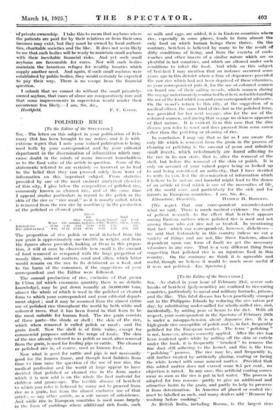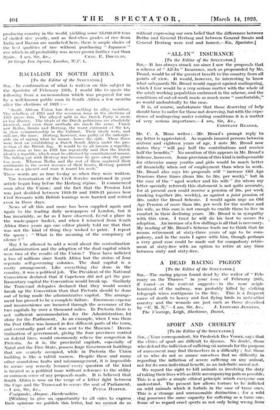[To the Editor of 'the SPECT.1TOR.] Sni,—As stated in your
issue of February 21st, severe out- breaks of beri-beri (poly-neuritis) arc confined to rice-eating countries, particularly to naval and military barracks, prisons, and the like: This fatal disease has been practically stamped out in the Philippine _Islands by reducing the rice ration per day, by substituting under-milled for wholly-milled rice, and, incidentally, by *adding peas or beans to the diet. With all respect, your correspondent in the Spedator Of February 28th is under a misapprehension about Japanese rice. It is a high-grade rice susceptible of polish and is, in fact, frequently polished for the European market. The term " polishing " is not, however, always correctly applied. After the rice has been rendered quite white by milling off the skill or cuticle under the 'task, it is frequently brushed " to remove the fine dust still adhering to the kernel, and this is the true " polishing " process. The rice may be, and frequently is, still further treated by artificially glazing, coating or facing the white kernel with some mineral matter. Provided that this added matter does not exceed some 0.5 per cent., no objection is raised. In any case, this artificial coating comes away as soon as the rice is put in hot water. The process is adopted for two reasons--partly to give an additional and attractive lustre to the grain, and partly to help to preserve it from deterioration. In America all glazed or coated rice must be labelled as such, and many dealers add " Remove by washing before cooking."
As British India, including Burma, is the largest rice-
producing country in the world, yielding some 35,000,000 tons of shelled rice yearly, and as first-class grades of rice from India and Burma are marketed here, there is ample choice of the best qualities of rice without purchasing " Japanese " rice which in all probability was never grown further east than















































 Previous page
Previous page